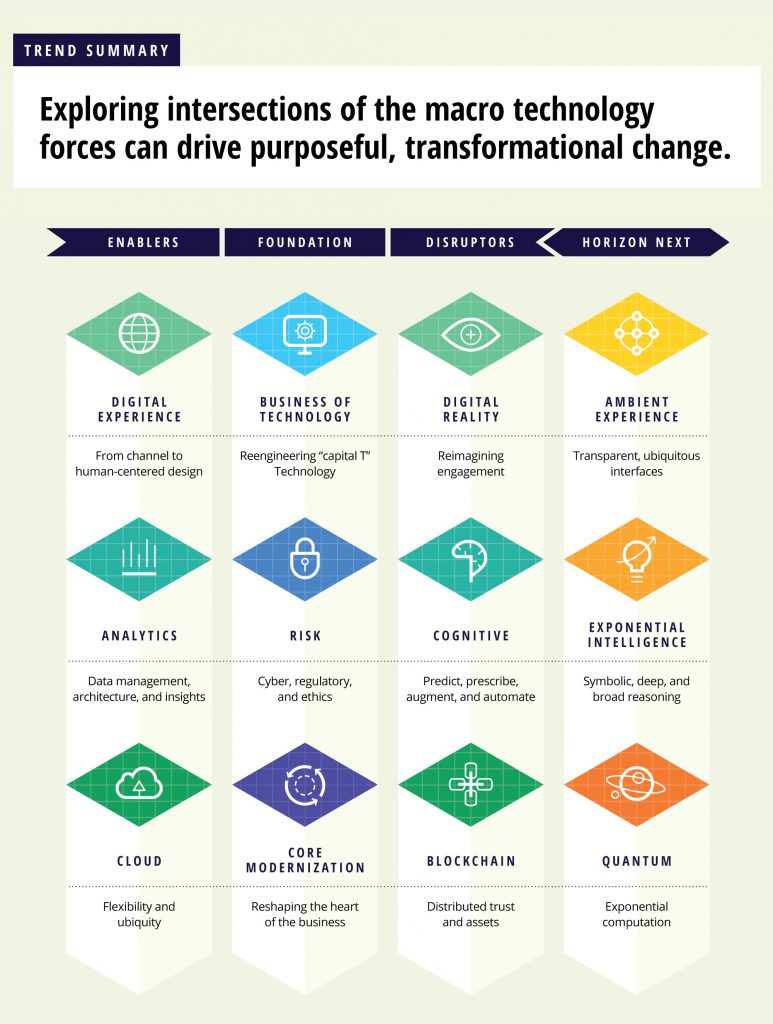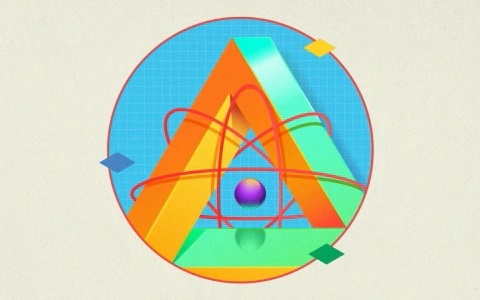A look at the pillars of past, current, and future innovation
As the unprecedented expansion of technology-driven innovation fuels a cross sector transformation in all areas, Computer Science and Engineering has been both the one that has brought about maximum of the changes, as well as the one which has itself transformed almost unrecognizably in past few years.
Emerging technology trends stir competing emotions and narratives, often pushing us beyond our comfort zones. Deloitte Tech Trends Report 2019
explored nine macro technology forces that have been—and continue to be—the backbone of business innovation and transformation: digital experience, analytics, cloud, digital reality, cognitive technologies, blockchain, the business of technology, risk, and core modernization.
For the ease of understanding, we have broken up the latest Emerging Technologies in Computer Science into few groups. Whereas Enablers and Disruptors refer to product or platform driven technologies, there are core business areas which are being impacted by the emerging technologies in unprecedented way. This is referred to as the Foundation Technologies.
- Enablers
- Digital experience
- Analytics
- Cloud
- Disruptors
- Digital reality
- Cognitive technologies
- Blockchain
- Use in Foundation Technologies
- The business of technology
- Enterprise Risk Management
- Process of Core modernization

macro technologies
Enablers
When we first came to face with digital experience, analytics, and cloud a decade ago, we understood the possibilities but weren’t quite sure how significant their impact would be. Since then, these now-familiar enabling forces have powered the disruption of businesses, operating models, and markets. They continue to evolve at an astounding pace.
Digital experience
It continues to be a critical driver of enterprise transformation—
Organizations are dispensing with the traditional notion of customer acquisition-focused marketing, focusing instead on creating more human-centric interactions—including with their own employees and business partners. Organizations are creating customized, emotionally intelligent digital experiences based on individuals’ behaviors, preferences, and emotions using an integrated array of AI capabilities such as voice stress analysis and microexpression detection tools. Consider, for
example, the use of EEG- and machine learning-enabled headsets that shed light on situations that distract or create stress for employees, enabling businesses to design better workflows and work environments.
Analytics
Analytics includes foundational capabilities and tools that generate powerful insights. Data management, data governance, and supporting architecture are age old problems that not only are critical building blocks for AI programs but are tactical concerns as organizations work in a dynamic and complex regulatory environment with mandates on data residency, privacy, and usage.
The tried-and-true concepts of “data at rest” and “data in use” are
joined by “data in motion,” which is supported by tools for data streaming, ingestion, classification, storage, and access. The good news? Cloud, core modernization, cognitive, and other technologies are bringing fresh solutions to an exceptionally complicated challenge.
Developments in data analytics have helped advance many of this year’s trends. For example, the ability to efficiently and cost-effectively process and integrate large amounts of data has spurred the creation of more advanced digital twin technology— but it has also created a deficit of trust, leading to our focus on ethical technology and trust.
Cloud
Cloud’s takeover of the enterprise is nearly complete. Ninety percent of organizations use cloud-based services5 and they aren’t putting on the brakes. In fact, cloud investments are expected to double as a percentage of IT budget over the next three years. In fact the use of cloud, extending beyond infrastructure, has given rise to everything-as-a-service, enabling any IT function to become a cloud based service for enterprise consumption.
Hyperscalers—the handful of massive companies that dominate the public cloud and cloud services industries8 —have shifted investments higher up the stack, providing platforms for advanced innovation in the other macro forces, including analytics, cloud, blockchain, digital reality, and in the future, quantum.
Cloud has also forced the reimagining of some tried-and-true roles. For example, giving architects the ability to take full advantage of modern cloud-based offerings plays a critical role in developing complex IT systems and applications in a hybrid world.
Disruptors
Today’s disruptors—digital reality, cognitive technologies, and blockchain—are the descendants of experience, analytics, and cloud. As the change agents of the coming decade, these newer trends may
no longer be considered novel, but they’re on the cusp of becoming as familiar and significant as their predecessors.
Digital Reality
Digital reality technologies, including AR/VR, mixed reality, voice interfaces, speech recognition, ambient computing, 360° video, and immersive technologies, promote more natural user engagement by seamlessly extending a human-centric experience beyond the confines of keyboards and screens. The goal is natural, intuitive, and potentially imperceptible interactions with underlying technologies.
Commercial applications of digital reality are growing. For example many companies are using digital reality technologies to deepen emotional connections and empathy among customers and employees. And in digital twins, we see how digital reality can help bring the digital twin to life. Using
AR, a manufacturer can provide its workers with a view into 3D content from a digital twin, improving worker productivity.
Cognitive Technologies
Cognitive technologies, such as machine learning, neural networks, robotic process automation, bots, natural language processing, neural nets, and the broader domain of AI, have the potential to transform nearly every industry. These technologies personalize and contextualize the human-technology interaction, allowing businesses to provide tailored language- and image-based information and services, with minimal or no human involvement.
Demand for cognitive technologies is skyrocketing—IDC forecasts spending to reach US$77.6 billion in 2022—although their potential benefits are accompanied by significant trust and tech ethics considerations. Today a company can help build a reputation as a trusted global brand by being transparent about the use of cognitive technologies, evaluating the impact on customer trust, and proactively seeking to understand and mitigate the effects on customers and their data.
Blockchain
in Deloitte’s 2019 Global Blockchain Survey, it came out that Blockchain is a critical technology priority for over half of organizations today, and over eighty percent of organizations could identify compelling blockchain use cases. Results suggest that in 2019, the topic of enterprise blockchain discussions shifted from, “Will blockchain work?” to, “How can we make
blockchain work for us?”
Financial services and fintech companies continue to lead blockchain development, but other sectors—notably, government, life sciences and health care, and technology, media, and telecommunications—are also advancing blockchain initiatives.
Foundation
The business of technology, risk, and core modernization may seem prosaic and dull, but these forces are undeniably the heart of the business. And companies continue to make considerable investments and advances in these well-established domains. Combined, they provide a reliable, scalable foundation for digital transformation, innovation, and growth, and are a requirement for successful investments in analytics, cognitive, blockchain, and other disruptive technologies.
Business of Technology
Thebusiness of technology—how IT operates—is evolving as technology and business strategies converge. As companies increasingly look to reengineer IT not only to deliver operational excellence but to partner with business functions to drive value creation, many IT teams are shifting their focus from project delivery to product and business outcomes and adopting collaboration-enabling development methodologies such as Agile and DevOps.
The supercharged technology function can then help enterprises become more agile in their response to technology-driven market and business changes.
Enterprise Risk Management
Risks facing enterprises in an innovation-driven era extend far beyond traditional cyber, regulatory, operational, and financial threats. Top CEO and board risk management reveal that the top threats to their companies were those related to new disruptive technologies and innovations, ecosystem partners, brand and reputation, and organizational cultures—even as they acknowledged they hadn’t prepared for or invested appropriately to manage these risks.
Beyond the essentials of compliance and security, organizations are approaching the broader issue of trust as a corporate strategy driven by the potential risks that emerging technologies could have on products, services, and business goals. Ethical technology and trust examines the broad implications of trust—including ethics and responsibility, privacy and control, transparency and accountability, and security and
reliability—on an organization’s people, processes, and technology.
Process of Core modernization
Core modernization reflects the ongoing pressures that digital transformation, user expectations, and data-intensive algorithms put on core systems in the front, mid, and back office. Whether it’s digital finance, a real-time supply chain, or a customer relationship management system, core systems support key business processes.
Many CIOs recognize that their legacy systems lack the agility to innovate and scale, with many rolling out next-generation ERP or modernizing legacy platforms.
In an era of instantaneous, always-on, tailored interactions, organizations need to lower their overall technical debt. Thoughtful approaches to modernizing the core—reengineering existing legacy systems, refreshing ERP systems, and rewriting systems—are more important than ever. While organizations are using new platforms to get the benefits of agility, automation, security, and scalability; those who understand and implement them are bound to reap the benefits.
Emerging forces on the horizon
As the three disruptor forces are gaining ground and are poised to make significant business contributions in the coming decade, three technology developments and innovations—the horizon next—are waiting in the wings. We will begin to feel their impact toward the end of the 2020s.
Ambient experience
Ambient experience envisions a future in which technology is simply part of the environment. Computing devices continue to increase in power and shrink in size. These ever-smaller devices are evolving our input from unnatural (pointing, clicking, and swiping) to natural (speaking, gesturing, and thinking) and their interactions from reactive (answering questions) to proactive (making unanticipated suggestions).
As devices become seamless and ubiquitous, they and we are becoming increasingly inseparable. Imagine a future world where tiny, connected, context-aware devices are embedded throughout the office, home, and beyond, functioning as part of the background. Or neurofeedback technology that today enables game-playing through brainwave analysis could serve as the foundation for direct brain and neural interaction, allowing us to think a question or request and have an appropriate response or action delivered to our ambient experience. For example, thinking, “I need to leave for the airport in an hour” could trigger a cascade of background activity, including arrangements for automated flight check-in, a virtual boarding pass for biometric screening, a self-driving car programmed to activate at the correct terminal, setting your home smart system to “away,” and halting deliveries for the duration of the trip.
Exponential intelligence
Exponential intelligence will build on today’s cognitive capabilities. Today, machine intelligence can find patterns in data but can’t interpret whether those patterns have inherent sense. It lacks the ability to recognize and respond to the nuances of human interaction and emotion. And it is also very narrow—it can defeat a human chess grandmaster but can’t understand the need to flee from a room on fire.
The future promises more. With semantic and symbolic understanding, machines will be able to tease out actual causality from spurious correlation. Our virtual assistants will increasingly be able to recognize—and adapt to—our moods. And as researchers make progress at creating broad, not just narrow, expertise, exponential intelligence will be able to move beyond the statistical and computational. It will ultimately lead to more capable AI with, dare we say, personality.
Quantum Power
Quantum harnesses the counterintuitive properties of subatomic particles to process information and perform new types of computation, communicate “unhackably,” miniaturize tech, and more. For quantum computing, the special properties of these quantum bits, or qubits, have the potential to create exponential change. By manipulating individual particles, quantum computers will be able to solve certain highly complex problems that are too big and messy for current supercomputers—from data science to material science.
As researchers overcome current technical limitations, quantum computers will increasingly supplement classical computers. Data scientists will be able to scan ever larger volumes of data for correlations; material scientists can use qubits to simulate atoms in ways that are impracticable on classical computers; and fascinating possibilities exist in many other areas including communications, logistics, security and cryptography, energy, and more.
Nine shifts which will help deliver on the promise of the Emerging Technologies
Nine shifts can help businesses organize effectively and upgrade their innovation chops to realize the collective benefits of the macro forces. Each of these interconnected shifts influences the others; applying them in concert can help businesses achieve the most effective outcomes.
- Agility and speed. Agile capabilities, organizational design, culture, work style, funding, governance, and sourcing can help companies innovate rapidly.
- Innovation and ecosystems. A radar for disruptive technologies, an innovation ecosystem, and a pipeline of ideas can enable continual innovation.
- Blurred internal boundaries. Embedding technologists in business functions can extend technology funding and accountability deeper into the business.
- Future workforce. As traditional IT tasks and capabilities disappear, businesses seek talent with new technical skill sets and soft skills.
- Governance and funding. Leaders can consider making governance and funding changes that support technology innovation and a product-centric focus.
- Leadership and culture. Leadership skills and a supportive culture can help companies recruit, develop, and inspire the technology workforce.
- Digital transition. Every company’s transition from digital experience to digital reality will have a different focus, type of leader, and structure.
- Data organization. Data-focused organizations extend the focus of analytics from operational efficiency and risk management to value creation.
- Cloud adoption. Adopting the cloud typically shrinks the centralized IT organization and promotes value cocreation in addition to operational excellence.

